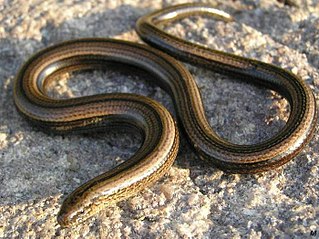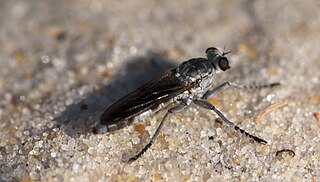
Salix × fragilis, with the common names crack willow and brittle willow, is a hybrid species of willow native to Europe and Western Asia. It is native to riparian habitats, usually found growing beside rivers and streams, and in marshes and water meadow channels. It is a hybrid between Salix euxina and Salix alba, and is very variable, with forms linking both parents.

The common slowworm is a species of legless lizard native to western Eurasia. It is also called a deaf adder, blindworm, or regionally, a long-cripple, steelworm and hazelworm. The "blind" in blindworm refers to the lizard's small eyes, similar to a blindsnake. The common slow worm, i.e. the species Anguis fragilis, is often called simply "slow worm", though the entire species complex Anguis is also called "slow worms".

Atrina fragilis, the fan mussel, is a species of large saltwater clam, a marine bivalve mollusc in the family Pinnidae, the pen shells.
Gonioglyptus is an extinct genus of trematosaurian temnospondyl within the family Trematosauridae. It is known from the Early Triassic Panchet Formation of India. It contains two species: G. longirostris and G. fragilis. The species G. kokeni from Pakistan has since been reclassified into Aphaneramma.

Stichopogon is a genus of small robber flies of the subfamily Dasypogoninae. There are at least 100 described species in Stichopogon.

Opuntia fragilis, known by the common names brittle pricklypear and little prickly pear, is a prickly pear cactus native to much of western North America as well as some midwestern states such as Illinois, Iowa, Wisconsin and Michigan. It also occurs in several Canadian provinces. It is known from farther north than any other cactus, occurring at as far as 56°N latitude in British Columbia. There is an isolated and possibly genetically unique population in Eastern Ontario known as the "Kaladar population".

Gonyaulax is a genus of dinoflagellates with the type species Gonyaulax spinifera Diesing. Gonyaulax belongs to red dinoflagellates and commonly causes red tides. It can produce yesotoxins: for example, strains of Gonyaulax spinifera from New Zealand are yessotoxin producers.

Campodea fragilis is a species of two-pronged bristletail in the family Campodeidae.
Derambila saponaria is a moth of the family Geometridae first described by Achille Guenée in 1858. It is found in Sri Lanka, India, Sumatra and Borneo.

Stichopogoninae is a subfamily of robber flies in the family Asilidae. There are about 14 genera and at least 230 described species in Stichopogoninae.

Stichopogon abdominalis is a species of robber fly in the family Asilidae.
Stichopogon argenteus is a species of robber flies, insects in the family Asilidae.
Stichopogon colei is a species of robber flies, insects in the family Asilidae.
Mitostylus is a genus of broad-nosed weevils in the beetle family Curculionidae. There are about seven described species in Mitostylus.

Stichopogon trifasciatus, the three-banded robber fly, is a species of robber flies, insects in the family Asilidae.

Stichopogon catulus is a species of robber fly in the family Asilidae.
Microphotus fragilis is a species of firefly in the family of beetles known as Lampyridae. It is found in North America. They tend to be more easily found in desert landscapes. This species of firefly is known for its huge eyes that are accompanied by a strongly convex pronotum.
Tipula fragilis is a species of large crane fly in the family Tipulidae.

Salix euxina, the eastern crack-willow, is a species of flowering plant in the willow family Salicaceae, native from Turkey to the Caucasus. It was first described by I. V. Belyaeva in 2009. It is one of the parents of the common crack-willow, Salix × fragilis.












